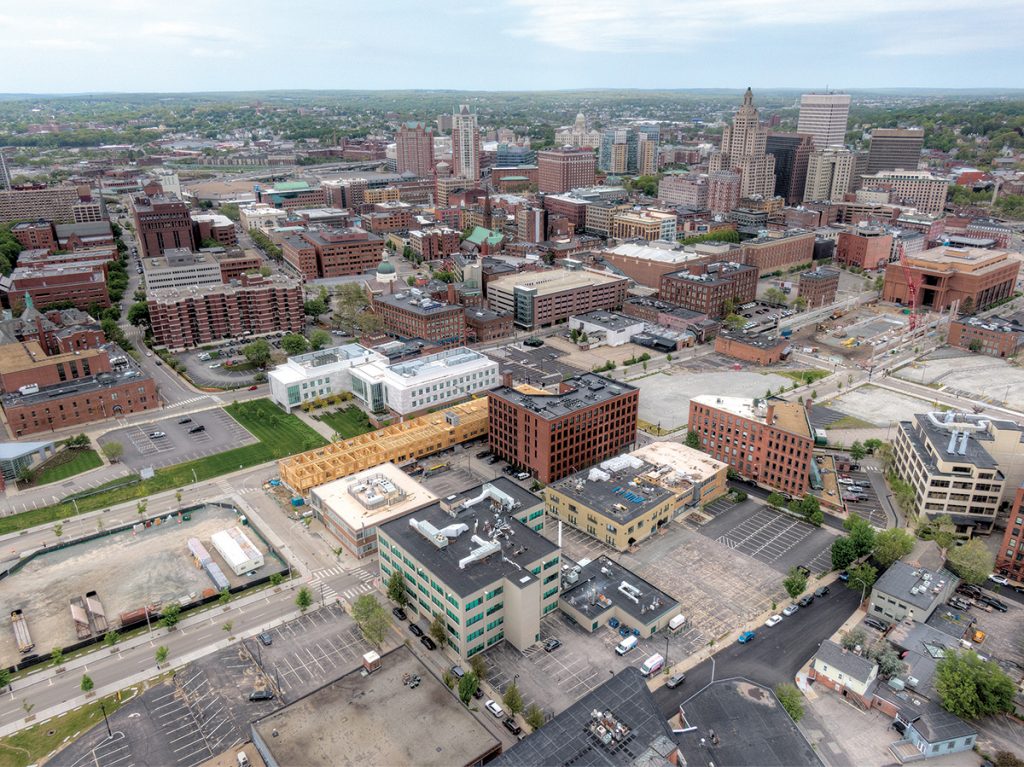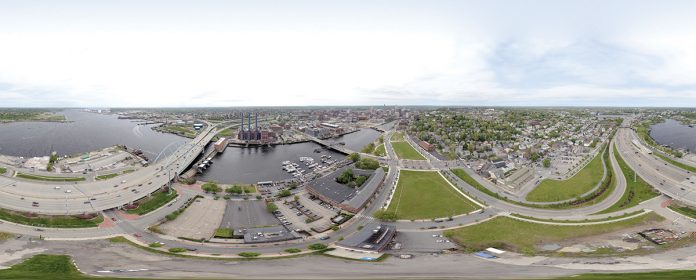When Robert Davis, a longtime real estate lawyer, joined the board of the I-195 Redevelopment District Commission in 2015, he’d talk to potential developers about the available land. It usually didn’t make for an engaging conversation. Most weren’t interested.
“We’d talk to people here,” Davis said. “We’d talk to people in other locales that had a booming economy. And people were very polite, but they had very little interest.”
It wasn’t the city, which has troubled finances but even by then was attracting younger workers. There just wasn’t demand for the 19 acres of buildable land. “You can line up every developer in the world to try to do projects,” said Davis, now chairman of the commission. “But if there aren’t users, nothing is going to get developed.”
Within a few years, the land started to attract more interest. And today, active construction is visible on several of its parcels. Less visible is the initial selection stage, at which multiple teams have sought publicly to be chosen for parcels.
What’s changed? There is strong demand among developers for apartment construction in Providence. And the presence of Wexford Science & Technology, a company that creates innovation districts paired with research universities, is commanding national attention.
The city has created a more accessible tax-incentive program, which offers the same long-term discount for all developers of large projects. And, maybe most importantly, the state has chipped in with dedicated enticements for commercial development in the district.
Still, almost 10 years after the state gained title to the 40-acre district, formed from the federal relocation of the original Interstate 195, there are some residents and political leaders concerned that it isn’t shaping up as quickly as hoped or with the optimal development mix.
[caption id="attachment_280240" align="aligncenter" width="696"]

FACING PAGE
JEWELRY DISTRICT: The I-195 Redevelopment District includes roughly 19 acres of developable land. In this photo, the construction of Chestnut Commons is visible at center. It will include 91 apartments over retail. Directly across Chestnut Street is the vacant Parcel 28, a site that attracted development proposals from five teams. The Garrahy Garage, a $37 million state project just outside the district, is under construction at top right. It will provide parking for district tenants.
/ PBN PHOTO/ARTISTIC IMAGES[/caption]
MEETING EXPECTATIONS?
Most developers submitting plans that make it to a public discussion are proposing a mix of retail or housing in new buildings. With the exception of Wexford, which is building an innovation center and hotel as part of its first phase of development, projects with commercial space haven’t come forward in great numbers.
Those that have – a massive project pitched for three contiguous East Side parcels by the Carpionato Group, and a smaller mixed-use building proposed by Waldorf Capital Management LLC for a site in the Jewelry District – didn’t have a dedicated tenant.
The $300 million luxury residential condo tower proposed by a New York-based developer, The Fane Organization, has captured much of the public discussion around the district in recent years.
But people who have been involved from the beginning are starting to argue about a different issue. Is it unfolding in such a way that it meets its original economic-development goal?
Senate President Dominic J. Ruggerio introduced legislation aimed at speeding the development review process, which he feels has been slowed unnecessarily in Providence. Others are concerned about the mix of uses.
Olin Thompson, a resident of the neighborhood who has attended I-195 commission meetings for several years, said many people expected the district would be populated with employers.
[caption id="attachment_280241" align="alignright" width="300"]

SEASONAL SEAFOOD: More than $300,000 in state funds were invested in site preparations to support the Dune Brothers seasonal seafood shack, intended to create a lively spot for people working in the district. The restaurant is located on Dyer Street.
/ PBN PHOTO/PAM BHATIA[/caption]
“We expected mostly commercial buildings,” Thompson said. “We expected health care, research-types of things and other technical kinds of businesses. What we’re getting to date is more residential.”
Thompson and other Jewelry District residents reject the idea that housing is the best use for the land. “The charter of the 195 commission is job creation,” Thompson said. “Residential does not create jobs. You need a janitor or a property manager. It’s not pursuing the mission of the district.”
The language of the 2011 act that created the district is more broadly written. It identifies a host of potential uses for the district, including housing.
Jan Brodie, the original executive director of the district, thinks it is unfolding as it should. The early years were consumed by getting the land ready for development. Clearing title snags, some of which dated to the 1950s when the land originally was acquired through eminent domain, and environmental remediation took years, she said.
When she arrived in 2013, the land was a blank slate. The work to coordinate utility improvements, to support large-scale construction and to provide a single wastewater runoff solution through the parks that line the river, was ongoing.
The land will be developed for commercial purposes, she said, not for nonprofit use. And the commission control was intended to remove the land-development decisions from the state and the city.
The vision was never purely commercial buildings, or office space, but mixed use, says Brodie, now executive director of The Pawtucket Foundation.
“Mixed income, mixed age, a mixture,” she added. “Just what cities are made of.”
The argument that the highest and best use of the land is a purely commercial center doesn’t reflect the reality of the market, she and other past and present I-195 leaders argue.
Student housing, she says, has changed dramatically in the last several years. It’s now privately owned and has become an economic tool in and of itself.
“We know students create vibrancy, and they are part of our economic development,” she said. “So is Wexford. So is more community-driven housing on the East Side. So is having a wonderful restaurant and a place to have coffee. All of those things are important.”
Stefan Pryor, the state’s commerce secretary, noted that HR&A, a consultant that advised the state on the district’s development, told officials they needed to do more than create business buildings.
Over the past several years, the district has put funds into “placemaking,” such as $320,000 to prepare a site for The Seafood Shack LLC, a seasonal seafood restaurant doing business as Dune Brothers.
And the $22 million Providence Pedestrian Bridge, while a state transportation project, has been seen by district leaders as critical to attracting new business. It is expected to open later this summer.
“The era of creating successful business districts, where in the evenings all that’s visible on the sidewalks and streets are tumbleweeds, that era is over,” Pryor said. “Businesses wish to locate themselves in vibrant, 24/7 districts.”
[caption id="attachment_280243" align="aligncenter" width="696"]

DEVELOPABLE LAND: Shown is an aerial shot of developable land in the Interstate 195 district of Providence. The Wexford Innovation Center is at center in the background and the Providence Pedestrian Bridge is in the foreground extending over the Providence River. The two land areas connecting the bridge will be developed into public parks.
/ PBN PHOTO/ARTISTIC IMAGES[/caption]
JOB FOCUS
The district covers about 40 acres, and of that, about 19 acres are divided into parcels that can be developed.
The area falls under existing Providence zoning. If no exceptions are made to that zoning, the potential buildout of the district is 4.5 million square feet, said Peter McNally, the most recent I-195 district executive director.
Given that amount of space, neither he nor other district leaders are particularly concerned about the dominance of apartment construction.
Still, the job-creation aspect of development in the district is what energizes the commission, and the staff, he said. “That is the focus. but they’re not mutually exclusive.”
The 4.5 million square feet that is potentially available across all of the parcels in the district allows for a vast mix of uses.
For context, the city’s downtown financial district has 1.5 million square feet, McNally noted.
“If you did 100% housing, you’d have 5,000 housing units there. It’s not going to happen,” he said.
Right now, the only active project in the district that is primarily residential is the Chestnut Commons building, under construction on Parcel 30, on Chestnut Street. A $32.9 million project of Waldorf Capital Management, it has 92 units.
Pryor, who lives in the Jewelry District, said no one should be concerned about residential construction crowding out office or other commercial space in the area. “We should be concerned about creating the critical mass of activity, office, hotel, university and residential that will further magnetize the district as a whole,” he said.
In reality, the I-195 district commission still has control over a number of available parcels. And the city has plenty of open spaces in the area that could be redeveloped. “Quite frankly, parking lots – galore, galore,” Pryor said.
[caption id="attachment_280242" align="aligncenter" width="696"]

INNOVATION CENTER: The $105 million Wexford Innovation Center, shown at right, is expected to open this summer. The 191,000-square-foot building will include space for Brown University’s School of Professional Studies, the Cambridge Innovation Center and Johnson & Johnson.
/ PBN FILE PHOTO/MICHAEL SALERNO[/caption]
A BIG DEAL
The state purchased the I-195 land after it issued $38.4 million in bonds in fiscal 2014. The money can be repaid with the proceeds of land sales in the district, or by special appropriations from the state. For the first five years of the bond issue, interest-only payments were made. The principal payments began starting this current fiscal year, when the state paid $1.4 million toward principal and $506,138 using a state appropriation, according to an R.I. Commerce Corp. spokesman.
The amount was lessened by $713,752 made from the sale of land.
If the state reamortizes the bond, the payments will continue through 2033.
While the I-195 commission has negotiated purchase and sale agreements that established prices for the land in the past year, two development teams have negotiated lower sale prices. In both cases, developers cited rising construction costs on the projects.
In the most recent, Wexford renegotiated the sale price for the land for the Aloft hotel project. The original purchase and sale agreement set the price at $15 per square foot, a figure that would have meant about $1.5 million, according to an I-195 spokeswoman. The renegotiated price for the land is a flat $1 million.
Despite some softening of demand, compared to four years ago, land in the district is under active construction in several locations.
Wexford is moving quickly toward completion on its $105 million Innovation Center, which will include space for Brown University’s School of Professional Studies, as well as space for the Cambridge Innovation Center.
On an adjoining site, the $55 million Aloft hotel project is moving forward on predevelopment tasks. The hotel site is part of the Wexford project, and will be leased to the hotel company. The hotel, which will have 169 rooms, is aimed at the business-traveler market.
The Fane Organization project is proposed for a parcel overlooking the district’s downtown park. The commission has given the 46-story project preliminary approval, but it has to clear several more hurdles with the city given its height and design.
Several more parcels have generated active interest among developers.
In the past month, the commission chose two projects for final consideration as preferred developer for Parcel 28, in the Jewelry District. And a Providence development team in May was chosen as preferred developer for Parcel 6 on the East Side.
Parcel 28 attracted five development proposals once the commission issued an RFP for the land last year. Four of the five involved construction of residential apartments.
Right now, this is the market for the land, according to commissioners.
Davis doesn’t see that as a detriment at all.
“Employers oftentimes will try to locate where the employees are,” he said. “Young people, in particular, like to live where they work now. And a lot of the techies are young. Having housing nearby makes it more attractive for them to want to live and work in Providence.”
[caption id="attachment_280244" align="aligncenter" width="696"]

LUNCH SERVED: People take a break from the hustle and bustle of the city at the new Dune Brothers seasonal seafood shack, located on Dyer Street in the Interstate 195 district of Providence. The restaurant will serve tenants working in the district.
/ PBN PHOTO/PAM BHATIA[/caption]
IS THIS THE PLAN?
There is no ideal mix of uses in the district, and the commission isn’t operating under any set formula for attracting different kinds of development, according to Colin Kane, the original I-195 chairman.
Kane served on the board from its inception until early 2015, shortly after Gov. Gina M. Raimondo took office – and swept out all but one of the previous commissioners.
No mix formula should be set, said Kane, because it isn’t going to reflect the market demand. The criticism of residential construction was being felt before he left the commission, he said.
“I fought hard,” he said. “Meds and Eds. Meds and Eds,” was what many people said they wanted on the land.
Why not a development goal of percentages for such development?
“Because it’s ridiculous,” Kane said. The development of the district will take decades, he says, and is unfolding as he thinks it should.
“Everybody’s got to get off this concept of mix,” continued Kane. “Every parcel is different.”
The market dictates use, he added. Right now, the market wants more housing, particularly for young people moving into the city center.
“Do you think every young employee wants to live in a single-family home in Scituate, or in Warwick or Cranston? They don’t. They want to live in a city,” he said.
With the adoption of state incentives, and a more predictable city tax-stabilization agreement – which provides a set phase-in for city property taxes, depending on the amount of the project – developers are expressing interest and moving forward.
The completion of South Street Landing, a $220 million complex just outside the district that houses Brown University offices and the Nursing Education Center for the University of Rhode Island and Rhode Island College, has served as an early anchor.
Former Providence Mayor Angel Taveras, now an attorney in private practice, believes South Street Landing, as well as the Warren Alpert Medical School at Brown, have acted as catalysts for the district.
He was among the last of the state and municipal leaders to sign off on the creation of the I-195 district. He feels it’s shaping up well. Apartments were always part of the mix he envisioned. In fact, the South Street Landing site includes two new apartment buildings.
“I’m not at all concerned about the fact that housing is going up,” he said. “That’s a natural development under the circumstances. Usually cities need to develop a critical mass downtown. I don’t think we’re at that critical mass yet.”
Mary MacDonald is a PBN staff writer. Contact her at Macdonald@PBN.com.

















